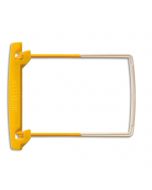We use cookies to make your experience better. To comply with the new e-Privacy directive, we need to ask for your consent to set the cookies.
Sort accurately by colour and reuse again as a raw material!

For those of you that know Jalema you are most likely to be familiar with the JalemaClip; that handy yellow and white adhesive mechanism for bundling almost all paper documents. The JalemaClip is made of plastic and unique in its kind - The mechanism is attached to various storage folders. Folders that are cleaned up after a certain period or whose documents are digitized, It would be a shame if the adhesive mechanisms were to be thrown away!
From old JalemaClip to new JalemaClip
A JalemaClip consists of three separate parts: a hose, a cover plate and a clip. These old parts can be of added value when making new parts. Of course it's a waste to just throw away all these parts, while they can be used as raw material for new clips! That was exactly the idea of Jalema. Recycling should be possible. The question that then remains: how do you get that organised? Of course, it is much easier (and takes less work) to make clips of new, or virgin, granulate, than to reuse old plastic products. Fortunately, that doesn't stop Jalema employees from looking for a practical way to put this into effect!
Step 1: Collecting old adhesive mechanisms
At I-FourC, Jalema's sister company, paper documents are digitized on a large scale - Jam-packed files are emptied and scanned. The old folders, possibly with adhesive mechanism, then become superfluous. The attachment mechanisms are removed from the folders after which the folders are disposed of. The remaining clips are collected in large boxes. Eventually Jalema retrieves these boxes of clips back from I-FourC
It is striking that the folders that were once (perhaps years ago!) sold at Jalema, are brought back to I-FourC in 2018 to be scanned or stored. Partly because of this, the recycling process of the clip is set in motion!
Step 2: sort clips accurately; colour by colour!
The boxes with old JalemaClips end up at the JAG. The JAG is part of Jalema and integrates people with a disability into the work process. There are now about 30 employees with a mental disability working at Jalema, also called participants. Because they are involved as full-fledged employees in a concrete production process, they really feel part of society, It’s great to see how they acquire a place in a company - You see the participants grow and become more independent!
At the JAG, the most important task of the entire recycling process of the JalemaClip is completed; the participants of the JAG sort out the parts of the old clips precisely by shape and colour. It is extremely important that no colours are mixed up, because this is ultimately reflected in the recycling process by a colour difference in products. The recyclable parts of the clip are then sent to the Injection Moulding factory at Jalema ready to be processed as raw material!
Step 3: old parts are shredded and melted down
About 25 million JalemaClips are produced annually in the IM plant - That's a lot! But, at the same time there are also a lot of old clips coming back to I-FourC that can be used as raw material for a new clips, in particular, the covers of the clips are used for recycling. During the production process of the JalemaClip, these 'old' parts are put in a grinding machine, in which they are shredded into small pieces.
Step 4: The machine starts working!
Together with the new granulate, a certain percentage of the chips are heated at high temperature by the production machine until they are liquid. With a certain speed and pressure this liquid is injected into the mould of the machine. The mould is made in the shape of the cover plate. This is cooled with water, which hardens the plastic and creates a new product, in this case a new part of the JalemaClip. This product is therefore partly made of new and partly of recycled granulate. In percentage terms, this means that approximately 5 to 10% of the clip is made from recycled material. Yet a special process, from old to new JalemaClip, a kind of own production process that Jalema has developed.
So you see, you're not always dependent on external parties for the supply of raw materials. In this way Jalema is self-sufficient on a fairly small scale and contributes to a better environment!

